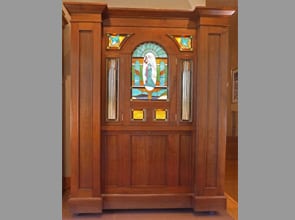
See current state of the O-roll Rollography HERE
Please contact me if you have rolls missing from the Rollography. CONTACT Rick Crandall
To hear a broad selection of great O-roll music, click HERE.
© 2015 Rick Crandall
Evolution of the American Orchestrion
Leading to the Coinola SO “Super Orchestrion”
The Genesis of Mechanical Music
The idea of automatic musical devices can be traced back many centuries. The use of pinned barrels to operate organ pipes and percussion mechanisms (such as striking bells in a clock) was perfected long before the invention of the piano. These devices were later extended to operate music boxes, using a set of tuned metal teeth plucked by a rotating pinned cylinder or a perforated metal disc. Then pneumatically-controlled machines programmed from a punched paper roll became a new technology platform that enabled a much broader range of instrumentation and expression.
During the period 1910 to 1925 the sophistication of automatic music instruments ramped up dramatically proving the great scalability of pneumatic actions and the responsiveness of air pressure and vacuum. Usually the piano was at the core but on larger machines a dozen or more additional instruments were added and controlled from increasingly complicated music rolls.
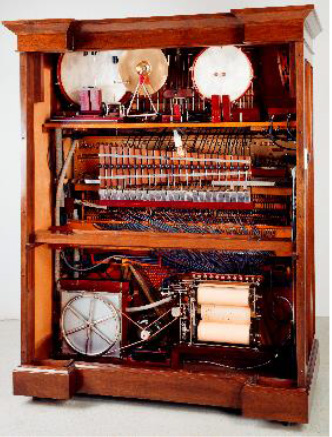
Internal view of the Coinola SO “orchestrion,” the most instrumented of all American-made machines.
Photo from The Golden Age of Automatic Instruments ©2001 Arthur A. Reblitz, used with permission.
An early example is the organ. The power for the notes is provided by air from a bellows, and the player device only has to operate a valve to control the available air. For motive power the early instruments were hand-cranked and the music “program” was usually a pinned barrel.
The ‘player’ device became viable in the 1870s. The development of the player piano was the gradual overcoming of the difficulties of controlled percussive striking (piano hammers striking strings) and expression.
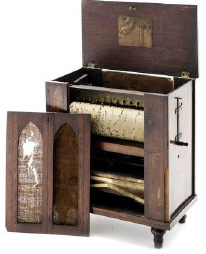
Hand-cranked barrel organ circa 1830 with changeable pinned “barrels”.
Various companies were founded in the later 1870s offering automated reed organs. These instruments started out with valve-less actions, the air flowing through the punched paper holes sounded the reeds directly. As instruments grew more complex, valves were added to switch on and off (i.e. digital) the air flow, ensuring a faster response and requiring smaller holes in the paper. The valves effectively worked as amplifiers, a small air flow being used to switch a much larger volume of air.
At the end of the 19th century and the beginning of the 20th, most music boxes were gradually replaced by player pianos, which were louder and more versatile and melodious, when kept tuned. Also phonographs came on the scene which had the advantage of playing back voices although they were not good at reproducing piano and percussion instruments.
Commercializing Mechanical Music – Coin Operation
It didn’t take very long for entrepreneurs to conceive the idea that a music machine that was coin-activated could replace live bands traveling the country – with better profits and avoiding the aggravation and cost of dealing with musicians’ unions. The whole idea of coin-operated amusement was brand new and turned into a flood. The U.S. Patent Office was granting patents for coin slots all through the 1890’s and early 1900’s. Coin operation was applied to gambling devices, vending machines and arcade machines in addition to music machines.
The piano, pipes and percussion were more suited to public places since the alternatives of the phonograph and the music box lacked the musical power to be heard in a room filled with people.

Punched Paper Rolls – the First Practical American National Music Medium
During 1898 to 1930 music spread geographically through the use of automatic music machines controlled mainly with pneumatics. Air pressure and vacuum conducted through a maze of tubing allowed for astonishingly responsive actions needed to actuate a piano action, organ pipes (imitating string and wind instruments), percussion (drums, xylophone, bells, wood block, triangle, etc.) and even the most difficult of all – plucking a banjo and bowing real violins. Control is from a punched-paper roll that travels over a metal “tracker bar” with a horizontal line of holes that align to sense the holes in the roll as they pass over the tracker bar. When a hole in the roll passes over a hole in the tracker bar, vacuum release in the connected tube triggers a specified action such as playing a musical note in the machine.
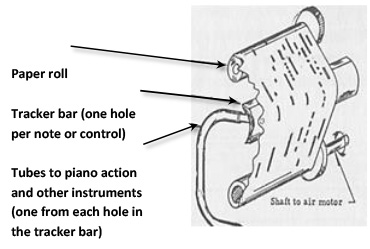
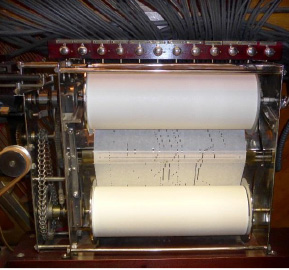
Roll frame and tracker bar from Coinola SO
Automatic music machines were important to the music scene not only for their technological cleverness and eye-catching appeal, but they did a good enough job musically to enable the spread of a popular tune or whole genre of music as a standard. Hundreds of blues and rags were captured on music rolls, in some cases uniquely on music rolls that were then mass produced and distributed nationally. These machines also were an economic means for many more establishments to have on-site music – restaurants, hotels, saloons and houses of ill-repute.
The Encore Banjo – First American Coin-operated Music Machine
The first American coin-operated motor-operated music machine appeared in patents dating back to 1893 and was in commercial operation by late 1897. Interestingly it wasn’t a piano; rather it was a roll-playing banjo! The Crocker-Wheeler motor found in the early Encores had the distinction of being the first electric motors to ever be powered from mains – i.e. the early Edison power plants installed for New York City. The motor itself looks as antique as the Encore. More on it and the Encore story can be found at: The Encore Automatic Banjo).
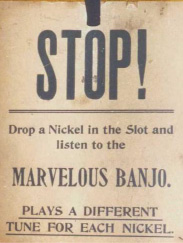
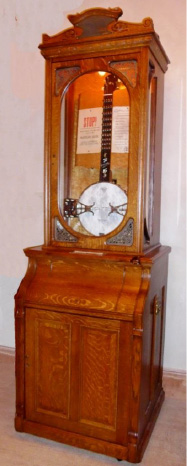
Encore Banjo circa 1902
Crandall collection
The Tonophone and the Peerless D – The First American Coin-op Pianos
The Tonophone embodies pneumatics but is still controlled by a long pinned barrel. It was developed by the DeKleist Barrel Organ Factory in North Tonawanda, NY for Rudolph Wurlitzer Co. and first marketed in 1899. Then in 1902, the Peerless Player Piano Co. of St. Johnsville, NY introduced several models of the first coin-op, paper-roll-operated pianos, starting with the Peerless D keyboard piano (see https://www.rickcrandall.net/peerless-first-coin-pianos/).
The race for consumers’ nickels was under way!
Evolution of the Orchestrion
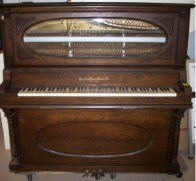
Peerless D Piano
The early 1900’s was a time of rapid growth in the field of coin-operated pianos and orchestrions. The J.P. Seeburg Piano Company of Chicago became the largest American manufacturer. Chicago was rapidly becoming the center of the industry. The Marquette Piano Company, under its Cremona brand and The Operators Piano Company under its Coinola brand furnished plenty of competition. The Peerless Piano Player Company of St. Johnsville, NY, expanded its business to an extensive line of instruments. The Rudolph Wurlitzer Manufacturing Company in North Tonawanda, New York, manufactured and also represented many different models, some of which were imported from Germany.
The marketing and advertising of these machines hit a crescendo of praise, claims and exaggerations. Here are excerpts from a Wurlitzer ad:
“The perfect rendering of music by mechanical means is one of the problems that has taxed human ingenuity since the first appearance of the time-honored hand-organ. The many efforts in this direction, although meritorious, have heretofore failed to reproduce the composition as exercised by the players.”
“In the latest invention … the hearer receives the same impression as if the performance were given by regular musicians. The cases are artistic in design and would be an ornament wherever placed. Throughout both material and workmanship will bear the closest inspection. Where music lovers congregate, as in resorts, beer gardens, hotels, cafes, saloons, dancing pavilions, ice cream parlors and penny arcades there is nothing to equal their attraction and ability as a money-maker.”
The Europeans were making automatic organs and other music machines before the Americans, the most sophisticated of which were German and French. The early European automatic-music-machine market was very much oriented to classical, dance and march music. The first two American machines, the Encore Banjo and the nickelodeon piano were of limited scale, playing popular musical arrangements in which rags, blues, and other popular tunes of that period are found in profusion. There was to be little opera and classical music for the rough-and-ready American market.
Reactions to the automatic player were varied. Here’s one from the October, 1911 issue of the Music Trades Review about their presence in houses of ill repute or “parlors:”
“The parlor houses of the Barbary Coast [the San Francisco red-light district] derived a considerable income from the sale of beer in bottles – and from music. Practically every resort was equipped with some type of automatic musical instrument which played only when fed with nickels or quarters. A great deal of the revenue from the music and sale of liquor went to the police and politicians as graft in addition to the regular payments which were usually based on the number of girls in a house.”
“In the late spring of 1911 (in San Francisco}, the police forbade all music in houses of prostitution and ordered the removal and destruction of every musical instrument in the red-light district. A month later in July, the proprietors of the houses were told that they might provide music for the entertainment of their guests, but that it must be music of the Automatic Harp.
There wasn’t such an instrument to be found in the Barbary Coast, but the void was soon remedied. A few days after the house owners had been notified, a salesman for a Cincinnati piano house [that would be Wurlitzer] appeared in the district and offered Automatic Harps for sale at $750 each, about four times what they could have been bought for in the open market. . .”
Why was a coin-op automatic harp OK but a coin-op piano wasn’t OK for a house of ill repute? I can only guess what the local politicians were thinking then, but that goes in general today as well! The kind word would be “lobbying” but likely involved bribery. In fact much of the music on Automatic Harp rolls wasn’t harp music at all, it was piano-roll music translated to pluck the harp strings like a piano.
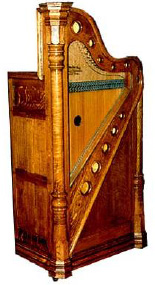
This anecdote refers to the Automatic Harp (pictured) made by the J.W. Whitlock Co. of Rising Sun, Indiana and marketed by Wurlitzer.
The Operators Piano Company and Coinola
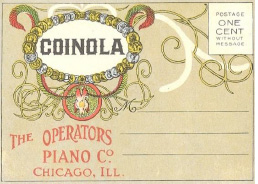
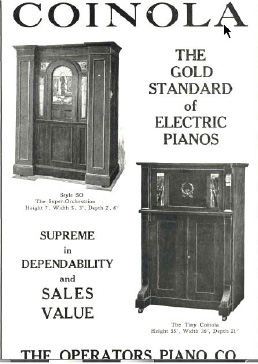
Music Trades Review
December, 1921

Presto Times
March, 1930
The Operators Piano Co. was founded in 1909 by Louis M. Severson, who came to Iowa from Norway with his parents in 1883 at one year of age. By the age of 22, Severson started repairing pianos in 1904 and had a small repair shop on Lake Street in Chicago. Then in July 1909, at the age of 27, he founded the Operators Piano Co. with C. R. Dibble of the Butte Piano Co. and Alfred Livingston of The Star Music Co.. Severson was the mechanical genius behind the Coinola machines. The company grew by using piano dealers as its sales channel. The addition of coin-op instruments was a natural.
The Company’s strategy was to target the route operators, i.e. those who placed and serviced coin-op machines on location, usually on a profit-sharing basis with the proprietor of the establishment.
Hence the company name, “Operators” and its “Trouble Proof” theme. Easy maintenance was essential for route operators.
The company was very successful with coin-operated pianos, and competed well against Seeburg. A scan of the Music Trades Review and the Presto Times trade magazines from the late ‘teens to 1928 shows frequent ads by Operators.
In 1914, while the “A” roll remained basic, Operators introduced the Style D machine, which added percussion, and with it the “O” roll was introduced. The new roll format featured perforations for extra instruments plus a 24-note solo section for up to two added instruments such as orchestra bells, xylophone, violin pipes, or flute pipes. The “O” roll provided for the two highest octaves of the piano to be muted when it played a solo on the extra instrument. The Coinola “O” roll became especially popular for its solo feature in combination with highly-reputed musical arrangements.
The Coinola X
Standardization was an efficiency practiced by the firm, and the same piano and case design was used for several different models, depending on the interior contents. “Especially illustrative of the success of President Louis M. Severson of the Operators Piano Co. in accomplishing this end is the new orchestrion that the company is bringing out. It contains in addition to a fine-toned piano, eight instruments—a mandolin, bass drum, snare drum, cymbal, triangle, tympani, orchestra bells, and Indian block,” commented The Music Trade Review. This was the Coinola Style X, representing a big jump from the previously introduced D and E series. The Coinola X became a best seller and was advertised steadily through to 1929. It is a popular machine in collections today.
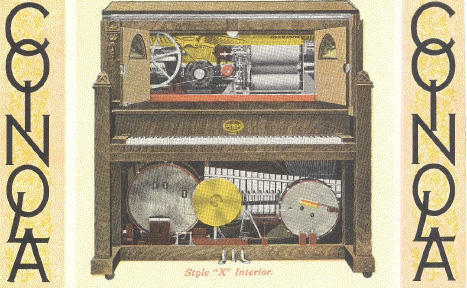
According to Don Teach of Shreveport, LA, who is one of the biggest Coinola fans in the collecting field:
“The snare drum beater assembly could easily have been placed in any model as they were all the same. The bass drum shelf is the same in most models with slight modification in models without the tympani beaters. The bass-drum assembly is the same in the X, CO, and SO. The triangle and wood block valves were the same in all models with a wood block and triangle. Coinola was one of the more consistent makers of coin pianos with slight variations in the valve design over the life of the Coinola’s. They could take any cabinet and put the components in the cabinet to make any model.”
In 1915 the company introduced the Reproduco brand name used for non-coin-op, self-playing piano-pipe organs playing a special “NOS” roll. In 1916 the Coinola Midget cabinet-style keyboardless machines were introduced to compete against the Seeburg K & KT cabinet models.
The Coinola CO Introduced in 1919
The Coinola Style CO, sometimes called the “Big Coinola,” is a keyboard piano with a case extension on the top. It was introduced in 1919 and promoted as ideal for larger places of public amusement. Instrumentation is piano, mandolin effect, xylophone, flute pipes, bass drum, tympani effect, snare drum, cymbal, triangle, tambourine, and Indian woodblock. A row of switches turns each percussion instrument off individually.
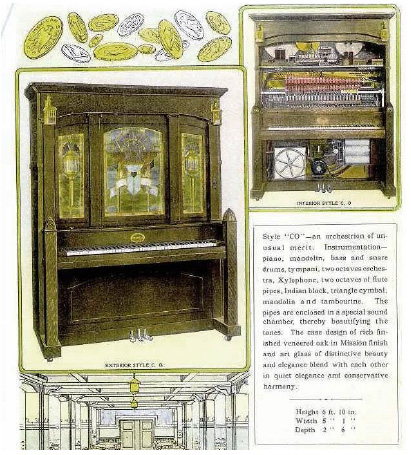
The Music Trades Review,April 7, 1923, included this:
“Coinola Style CO Has Big and Growing Demand:
The Coinola Style CO, made by the Operators Piano Co., Chicago, is one of the most practical instruments produced by this company. The demand for this instrument is greatest from big amusement houses and road houses.”
Coinola SO – The “Super Orchestrion” Introduced In 1920
In 1920 the Style SO Orchestrion, called “Super Orchestrion” was brought to market, with much public fanfare. It is the most extensively instrumented “O” roll machine. Operators aimed this machine at higher-class places as described in an article in the
Music Trades Review, January 8, 1921:
“The feature of the catalog is a new style SO orchestrion. It is of the new design with a full complement of orchestral effects… conspicuous for the superb artistry of glass panel designs and coloring, soft neutral tints predominating…. Giving an idea of the extremely high-class places into which Coinolas find their way: hotel lobbies, high grade restaurants, hotel billiard parlors, etc.”
A close look at the Coinola SO case from a design perspective shows careful attention to Operators’ stated goal of “refined elegance.” Years earlier J.P. Seeburg, who took a course in design at Chicago’s Art Institute, pioneered the use of an arched window in the Seeburg K, in the 4 doors of the G and H, the panels in the Style F, etc. Wurlitzer also used this element in some of its PianOrchestra cabinets. By the time of Operators later introduction of the SO, they took many of these design elements and incorporated them using a more refined wood than the declining popularity of oak in nickelodeons. Tastes were changing, in part due to the rapid depletion and decline of the oak forests in Western Michigan by 1920. Oak furniture was increasingly painted instead of stained. Walnut and similar-appearing hardwoods, which were never used for rough lumber, were the continuing staple for more refined furniture.
Reminiscent of some of the European orchestrion case designs, the Coinola SO design employs imposing column effects and art glass elements that not only include the arch but the two top-corner glass treatments with bluebirds. Added to that are the long, elegant 3-dimensional organ pipes on the outer panels. The combination of artistic design and its instrumentation positioned the SO as the epitome of an O-roll machine which was clearly Operators’ goal.
The instrumentation is similar to that of the keyboard Style CO, but with an added rank of violin pipes and a 15-inch Chinese crash cymbal. The pump has a special “amplifier” pneumatic that raised the vacuum level and loudness of the percussion, especially effective with the crash cymbal. The flute pipes are melodias which are open wooden pipes described variously as smooth, singing, rich, warm and mellow. In the CO and SO they are enclosed in a “special sound chamber” with swell shutters that open and close under music-roll control for expression.
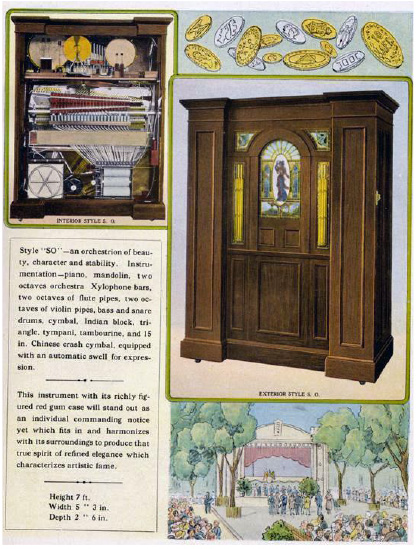
From the Coinola color catalogue circa 1921

Music Trades Review Ad
May 28, 1921
Coinola SO’s existing today are very rare. Only three original Style SO’s are known to exist although there is a rumor of a 4th somewhere in the Midwest. One was purchased by Steve Lanick from the original owner in North Adams, Massachusetts in the mid-1960s and is currently owned by Mike Argain. Another came from Haning & White who acquired it from Bob Nelson’s café in Oklahoma and is now in Jasper Sanfilippo’s Place de la Musique museum. The third was in Svoboda’s Nickelodeon Tavern for many years, acquired by Bob Gilson and is now in the Crandall collection. Each one of these machines that can be found in collections today have a “story.”
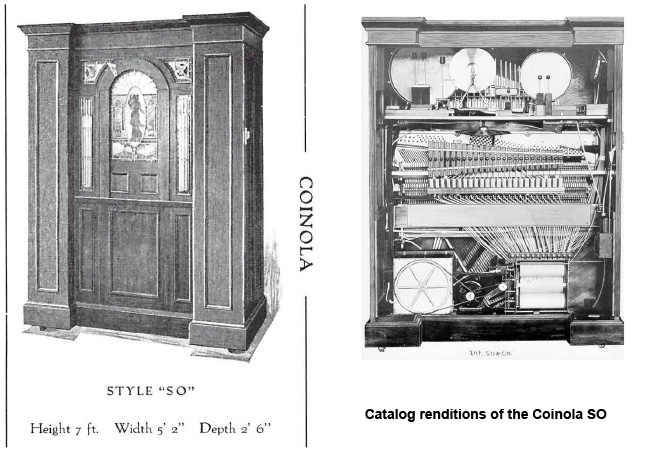
Of the Crandall machine, Art Reblitz recalls:
“Al Svoboda and Dave Ramey told me that they pulled this machine out of the basement of a gangster’s home in Blue Island, IL – they had to get it out fast and got everything except the front case parts. “The first time I saw it was through a window of Svoboda’s back room workshop around 1963. Dave Ramey got it working originally and then later when Bob Gilson purchased it, Ramey did a full restoration including getting the proper front case panels copied from the machine now owned by Mike Argain. Now that it’s in Rick Crandall’s collection I’m looking forward to restoring, regulating and servicing my old friend over 50 years later!”
Market introduction of the CO and SO was late in the cycle for larger orchestrions. Market emphasis in the middle of the 1920’s was on smaller instruments and cabinet styles. Estimates are that only about 50 Super Orchestras and 75 – 100 CO’s were ever made. By 1928 there was not much left of the market for coin-operated music machines. Ads by Operators disappeared and Coinola faded into history, although instruments were shipped into 1930.
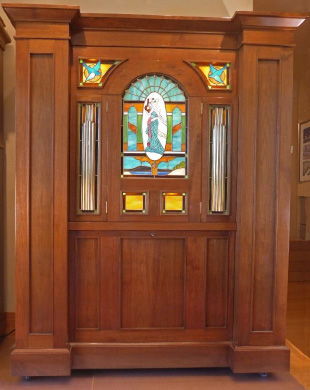
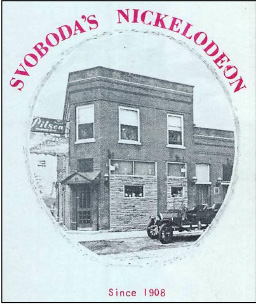
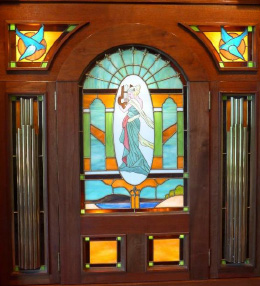
Coinola SO that was in Al Svoboda’s Nickelodeon Tavern in Chicago Heights, IL now in the Crandall collection.
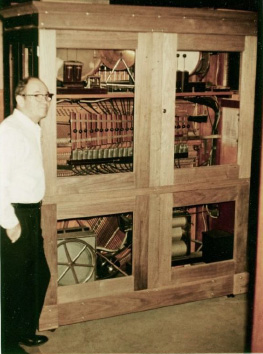
Al Svoboda next to the Coinola SO with temporary case facade. Ca. 1964

Coinola machines have on/off controls for each instrument – this from the SO, left to right:
tympani, bass drum & cymbal; tympani, Indian block; snare drum single; snare drum roll;
triangle; mandolin; pipes; xylophone, tambourine; crash cymbal
Operators “O” Roll
The earlier, simpler music machines made by Operators were pianos, with some models having one added instrument, typically a rank of flute pipes or a set of orchestra bells. They play the “A” roll which has 10 tunes per roll and became the industry’s most widely-used roll for basic automatic pianos. The “O” roll was introduced in 1913 which features perforations for extra instruments plus a 24-note solo section for up to two added instruments such as orchestra bells, xylophone, violin pipes and/or flute pipes. The O-roll signals for the two highest octaves of the piano to be muted when a solo is to play on the extra instrument in that same range.
The O-roll became especially popular for its solo feature plus some very gifted music-roll arrangers being employed by the roll-making subsidiary of Operators. They produced music rolls that are generally recognized as many of the best American orchestrion arrangements initially under the Columbia name and continuing after its name change to the Capitol Music Roll Co. in late 1924.
I became attracted to a larger O-Roll machine because my interests in American music tend strongly towards jazz, blues, boogies and rags for which the O-roll is particularly adept. As described more fully in Post Script C below, the O-scale plays 78 piano notes including notes at both ends of the range not found in the other formats that are very important to jazz themes. Also the O-roll solo instruments (pipes, xylophone or bells) are connected to the highest 24 playing notes which leaves a good piano compass – almost 2 octaves above middle C – for piano accompaniment playing while the solo instrument(s) are turned on and the piano in the solo range is turned off.
This will all be demonstrated with some specially-selected jazz, blues, rags and boogie old and new arrangements in a project that is underway.

While the O-roll was introduced in 1913, there is no mention of O-rolls in the trade press until 1919 when the Columbia began producing bulletins. According to an excellent analysis done of early O-rolls and arrangements by Art Reblitz, we know that the earliest O-rolls up to approximately O-400 in about 1920, have square perforations and were produced by QRS who advertised the benefits of square holes. Labels on all extant early rolls offer no logo identification as to who made them. In 1920 Columbia began adding its name to roll labels, initially rebranding QRS rolls and soon after, Operators hired Roy Rodocker as the head of the music-roll department. He had previously been head of the QRS coin-operated music division. He is credited with the excellence of arrangements characteristic of Columbia and Capitol.
In 1924 the Columbia changed its name to Capitol. The August, 1924 issue of Music Trades Review:
“A new addition to the Western music industry has been made in the organization of the Capitol Roll & Record Co., which takes over the Columbia Music Roll Co., changing the name of the music roll made by that company to the Capitol music roll …. The company has the financial backing and the executive, manufacturing and marketing experience of President L.M. Severson and his associates in the Operators Piano Co.…”
The name change was necessary because a line of Columbia records, indeed a leading brand of the Columbia Phonograph Company, was already in the market.
The Clark Orchestra Roll Co. which made a variety of roll types, began making O-rolls initially with 3-digit numbers dating at least as far back as December, 1920 (the early Columbia Music Roll days). We know there are Clark rolls in the number range 110 – 144 dating 1920 – 21. Note a comment in the December 4, 1920 >Presto Magazine indicating the start of their “O” roll designation:
“Henceforth all music for Coinola and Empress Orchestrions will be designated by the prefix “O” instead of “C” in order to prevent confusion in ordering.”
It is likely that Clark quickly sensed the confusion of roll numbers overlapping with Columbia and switched to roll numbers starting at 2000. Clark produced an estimated 290 O-rolls. The combination of QRS, U.S. Music, Columbia and Capitol produced an estimated 980 rolls in the numbering range 1 – 950 and a special WWI series between 1000 – 1030, for an estimated total of 1270 original O-rolls ever produced. Some O-Rolls have been found with National Music Roll Co. labels (owned by Peerless Piano Player Co.) but those have been tied back to Capitol & Clark masters, only re-labeled by National.
The popularity of the style ‘O’ music roll is widespread today. From Coinola experts and enthusiasts:
Don Teach: “… their orchestrions are the most listenable of all American Orchestrions … I also say that with the Capitol arrangements they’re the most realisticly sounding of nickelodeons!”
Frank Himpsl:“The O-rolls always fascinated me because there was music issued in that format that simply does not exist elsewhere. Not in published piano sheet music, and not even in manuscript lead sheets or band arrangements. Years ago I spent a great deal of time at the Library of Congress and the Copyright Office trying to track down some of the phantom titles that we know of only from the existing O-rolls (and other formats in some cases). Titles like “Irma Rag,” and “Ramrod Rag,” which are musically superb, are complete unknowns as to composer. Yet these tunes were widely heard via the Coinola instruments of the day, and they are an important part of our musical heritage. There are so many other tunes, also exceptional and similarly lost to time, were it not for the existence of these few rolls.”
Rick Crandall:“… particularly with the Columbia/Capitol arrangements, the tunes sound
especially more realistic, musical and human-played than the still fun but more mechanical sound of most American music-machine arrangements including the earlier QRS O-rolls.”
| See the O-roll Rollography at: https://www.rickcrandall.net/operators-o-roll-rollography/. Please contact me if you have rolls missing from the Rollography.Coinola owners: We will be selecting the best O-roll music of all existing rolls and some new arrangements for a special recut project. If interested, contact me at:Rick@AspenVenture.com. |
Effect on Business by Events Leading to Prohibition
The 1900 – 1917 period was one of social reform in the U.S. known as Progressivism. Progressives believed that, owing to alcohol, other social evils such as gambling and prostitution flourished. By 1917, the eve of American entry to World War I, 18 states had achieved complete alcohol prohibition in advance of the 18th Amendment to the Constitution in 1920 outlawing the sale of alcohol nationally. In The Music Trade Review, issue of March 31, 1917 Operators observed that the “dry movement” had succeeded almost everywhere, except in cities with large foreign populations. Some coin–op makers suffered, but
Operators didn’t. In the article, Severson stated:
“Other (than saloons) places of entertainment have sprung up including theatres, pool and billiard halls, drug stores, bowling alleys, and dance stores. They have a demand for automatic musical instruments, which offsets the demand of the saloon.…We have done more business in the state of Michigan since it was voted dry that we have ever done before in that state. Iowa, a dry state, buys more automatics than all but three other states,” he continued.
Technological Obsolescence – the Sun-setting of Coin Pianos and Orchestrions
The technical advances of the 1920s were largely in radio technology, the key development being the introduction of vacuum tubes and electrical amplification. It became possible to sit around the radio and listen as a family, unlike the earlier crystal sets which required the use of headphones. Amplification was also applied to the recording and playing of 78 rpm records. The electrical recording systems introduced around 1925 enabled a major rise in sound quality and volume of sound. Radio and the advent of electrically-amplified record changers (jukeboxes) rapidly eroded the market for the player piano, which declined from the mid-1920s onwards.
Coin-op electric phonographs were becoming very popular. Some piano companies including Seeburg (forming Western Electric), and Wurlitzer nimbly made the shift to the new technology. John Gabels’ Automatic Machine & Tool Company made the transition from acoustic record changers to electric. They were joined by newcomers such as Holcomb & Hoke (Electramuse) and Capehart. The radio also came into increasing use in restaurants and public places. By 1928 there was not much left of the market for coin-operated pianos and orchestrions. Advertisements of the Operators Piano Company disappeared from trade publications. Coinola faded into history, at least with regard to manufacturing, although instruments were shipped into 1930. When the Wall Street crash came in October 1929, the player piano was already in a very weak position, and sales effectively ceased. Coin-op pianos, and especially the larger orchestrions which are quite large physically, were destroyed with relatively small numbers surviving.
Post Script A: A 25-year look-back from the Automatic Age, October 1934 issue:
Do You Remember Music Units of Twenty-five Years Ago?
“Twenty-five years ago automatic music was an unknown quantity and the public still had to be sold on the subject, which proved to be no easy task.Machines were not operated then but sold on a time basis, the prices ranging from one to five thousand dollars. The principal product was the European Orchestrions which reproduced the music of from five to twenty-five musicians, in the old time German band style. The services of a couple of trucks, a staff of expert mechanics and several days time were required to transport and install one of these contraptions.
“This was also the day of the Tonophone, a 65-note pinned-cylinder piano which required several heavy-weight piano movers to change the music.Then came the perforated music-roll instruments – the Automatic Harp, which when played sounded like a child practicing on a zither and the 44-note Pianino, which was responsible for the creation of the term “Tin Pan Music.” Though they these sold for $1,000 each, they took the country by storm.
“The next step in the progress of automatic music was the appearance of the Hexaphone, a six-cylinder record machine, the Multiphone, a 24 cylinder record instrument and then the 24 selective-disc record machine (the Gabels Automatic Entertainer). None of these instruments were very successful … being non-amplified, not loud enough to fill an ordinary amusement establishment. The advent of the amplified phonograph remedied all of this and with its coming, the perforated-music-roll instrument and even the Violano, whch was probably the most popular machine of its day, had to make their exits.”
Post Script B: Dave Junchen’s Insight into Columbia and Capitol Music Rolls:
from AMICA article in 1983:
“The Columbia Music Roll Company was founded in 1920, simultaneously with the beginning of the Clark Orchestra Roll Company. Ernest G. Clark had purchased the coin operated division of the QRS Company, and Roy Rodocker, who had been head of the QRS coin operated division, was hired by the Operators Piano Company to form a roll making division in Chicago.
“When Columbia first began operations in 1920, their output was entirely rolls for the Coinola pianos manufactured by Operators, and many, if not all, of the arrangements were copied from QRS 88-note rolls. Within a year, however, Columbia decided to enter the 88-note market, which meant that they had to develop their own arrangements. I suspect that the first Columbia arrangements in 1921 were the work of Mr. Rodocker’s drafting board. By 1922 live artists were recording at the Columbia factory, and most popular 88-note rolls issued from then on list a performing artist on the label.
“Roy Rodocker particularly admired the playing of Negro musicians. Artists such as James Blythe, Clarence Johnson, Alex Hill, Lloyd Smith, and James P. Johnson are often seen on Capitol rolls. Mr. Rodocker also persuaded some of the Chicago theatre organists to record for Capitol, including Eddie Hanson, Irma Glen, Pearl White, and Al Carney. He didn’t neglect good white pianists, either – fine musicians like John Honnert and Charlie Garland also joined the Capitol roster.
“Quality was a hallmark of Capitol roll production from the 1920 beginning until the end in 1934. The musical arrangements under Roy Rodocker’s editorship were consistently superb – being easily the equal and frequently the finest of all the roll companies.”
Post Script C: by Art Reblitz
“The Coinola SO plays solos and has flutes and violins plus xylophone rather than bells, so it’s more subtle than a Coinola X with bells. Style “O” rolls are more available than H or M rolls, especially recuts. A good variety of music was made because both Clark and Capitol made O rolls.The Style CO and SO are very rare today due to their late entry into the market. This is unfortunate, as they are among the most listenable of all American orchestrions.”
Coinola O-Roll Scale: plays 78 piano notes on the larger machines including “octave coupling” of the lowest two octaves. The scale starts at E so the 78-note playing range omits only the lowest 7 notes (A-D#) and the highest 3 notes (A#, B and C) of a standard piano scale. Most Coinola Midgets have a 66-note piano due to no low-octave bass notes.
Seeburg G- Roll Scale: plays 60 piano notes, G# through G, 48 notes + 12 coupled in the bass, omitting the lowest 11 (A-G) and highest 17 (G#-C) notes.
A-Roll Scale: plays 58 notes C-A, omitting the lowest 15 (A-B) and highest 15 (A#-C). There are variations, including little cabinet pianos incl. Seeburg L and clones (e.g. Western Electric Mascot, Coinola Cupid) that have one octave-doubled bass note and 5 missing treble notes (F-A); large cabinet pianos including Seeburg K, Western Electric B, various Nelson-Wiggens, etc., that don’t play the lowest three notes on the piano and play the A roll two notes lower than usual (B#-G instead of C-A), and some others.
Cremona M –Roll Scale: plays 64 piano notes A-C, omitting the lowest 12 (A-G#) and the highest 12 (C#-C). Later M rolls use A-roll arrangements and only use the C-A note compass of the A roll.
Seeburg H-Roll Scale: have the same piano range as O rolls, except that the lowest three bass notes (E, F and F#) don’t have the lowest octave coupled and the pipe compass is very different, i.e. lower in the piano treble range.
Implications of the various roll-formats for arranging and playing jazz and blues music:
A rolls don’t have much low bass or high treble. M rolls have a little more. G-roll bass coupling goes down 4 more notes than an A roll, but only goes up to the G below middle C. That limits what can be done in the tenor range because many countermelody notes have to be played in the octave above middle C whereas they would sound better in the octave below middle C. Also, G rolls have fewer high treble notes than A or M and certainly than O or H.
O and H rolls stop the bass coupling at D# below middle C, providing more versatility than the G coupling, which consumes three more very important notes (E, F, F#). While this wouldn’t seem to make much of a difference, it does particularly with blues and boogies. When playing a repeated boogie-woogie pattern in the bass, it allows the octave jumps to be played more like they are on a regular piano without compromising for the octave coupler. In blues, an important bass line can be stronger with the octave coupling than in an A or M roll without it.
The O and H scales also go all the way up the treble to high A, providing almost the complete high treble that’s missing in the A and G rolls. This is important for duplicating higher-range piano solos that would otherwise have to be moved down an octave.
Finally,the O-roll solo instruments are connected to the highest 24 playing notes which leaves a good piano compass, – almost 2 octaves above middle C – for piano accompaniment playing while the solo instrument(s) are turned on and the piano in the solo range is turned off.
Post Script D: Date Line Relevant to Coinola
| 1900: – | QRS founded by Melville Clark; “supplying music rolls to the player piano market” |
| 1907: – | Style “A” roll designed and introduced for the first Cremona coin pianos made by Marquette in Chicago under the supervision of J.P. Seeburg |
| 1909: – | (July), Operators Piano Co. incorporated |
| 1913: – | (summer), Operators announced Style A Coinola piano using A rolls |
| 1913: – | (late) Style D introduced with percussion; first O-roll’s by QRS with square holes |
| 1914: – | O-Roll range including 78 to 92 produced by QRS; Coinola X introduced. |
| 1916: – | Coinola Midget line introduced |
| 1917: – | O-Roll range including 204 to 250 produced; still QRS |
| 1918: – | O-Roll range including 267 to 306 produced; still QRS – (November), U.S. Music Co. sold its six-per-inch perforators for A rolls to Columbia Music Roll Company division of Operators Piano Co. |
| 1919: – | O-Roll 398 produced by QRS labeled Columbia; Coinola CO released with xylo and pipes |
| 1920: – | Columbia starts producing rolls initially copying QRS 88-note piano rolls
|
| 1921: – | Columbia starts arranging their own music; Roy Rodocker becomes head of arranging. |
| 1924: – | (summer), Columbia name changes to Capitol still as a subsidiary of Operators. |
| 1930: – | Operators ads in trade publications cease |
| 1934: – | All over – Capitol stops producing rolls |
Many thanks go to Art Reblitz, Don Teach, and Frank Himpsl and Glenn Grabinsky, each among the most knowledgeable in Coinola machines, literature and O-Roll music. They have been very helpful as sources of information, music, notes and photos.


